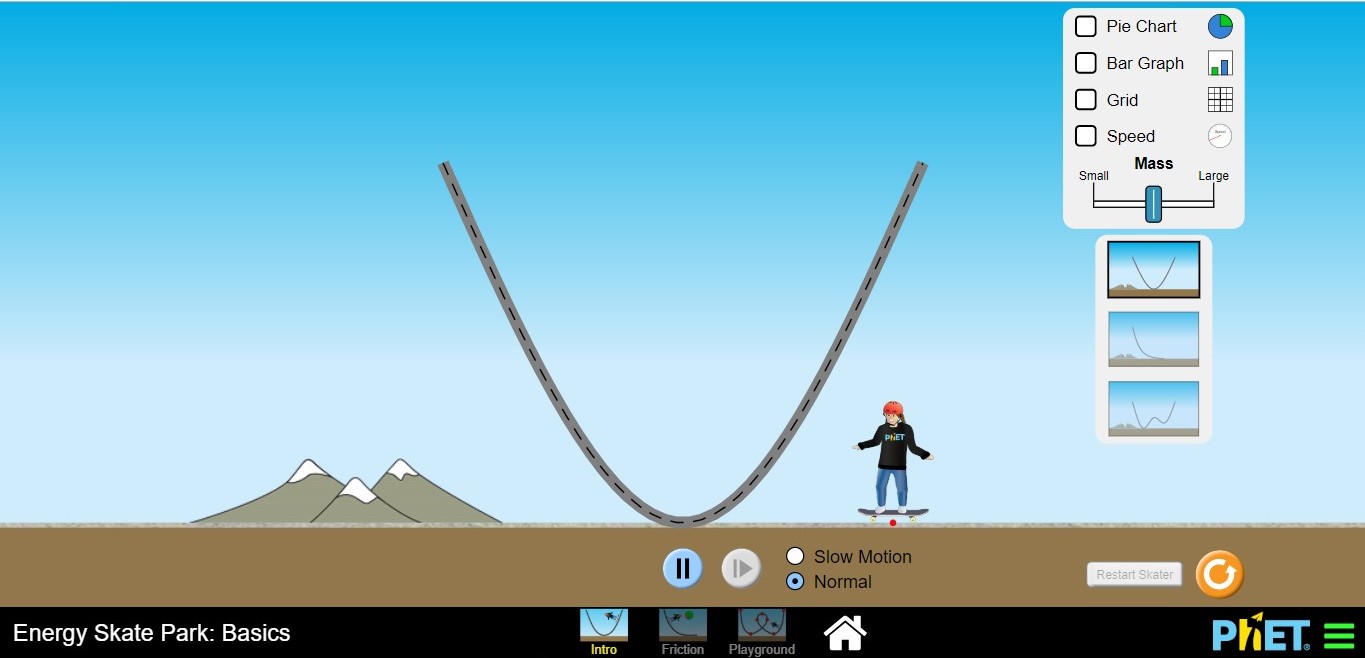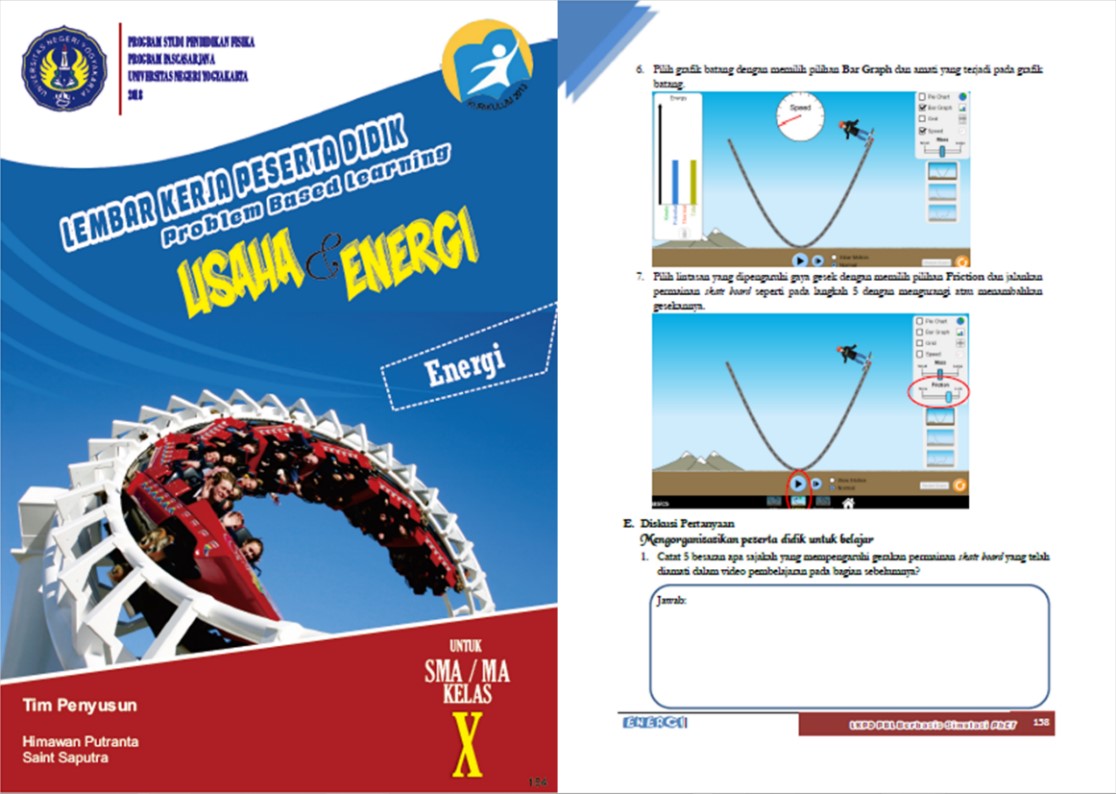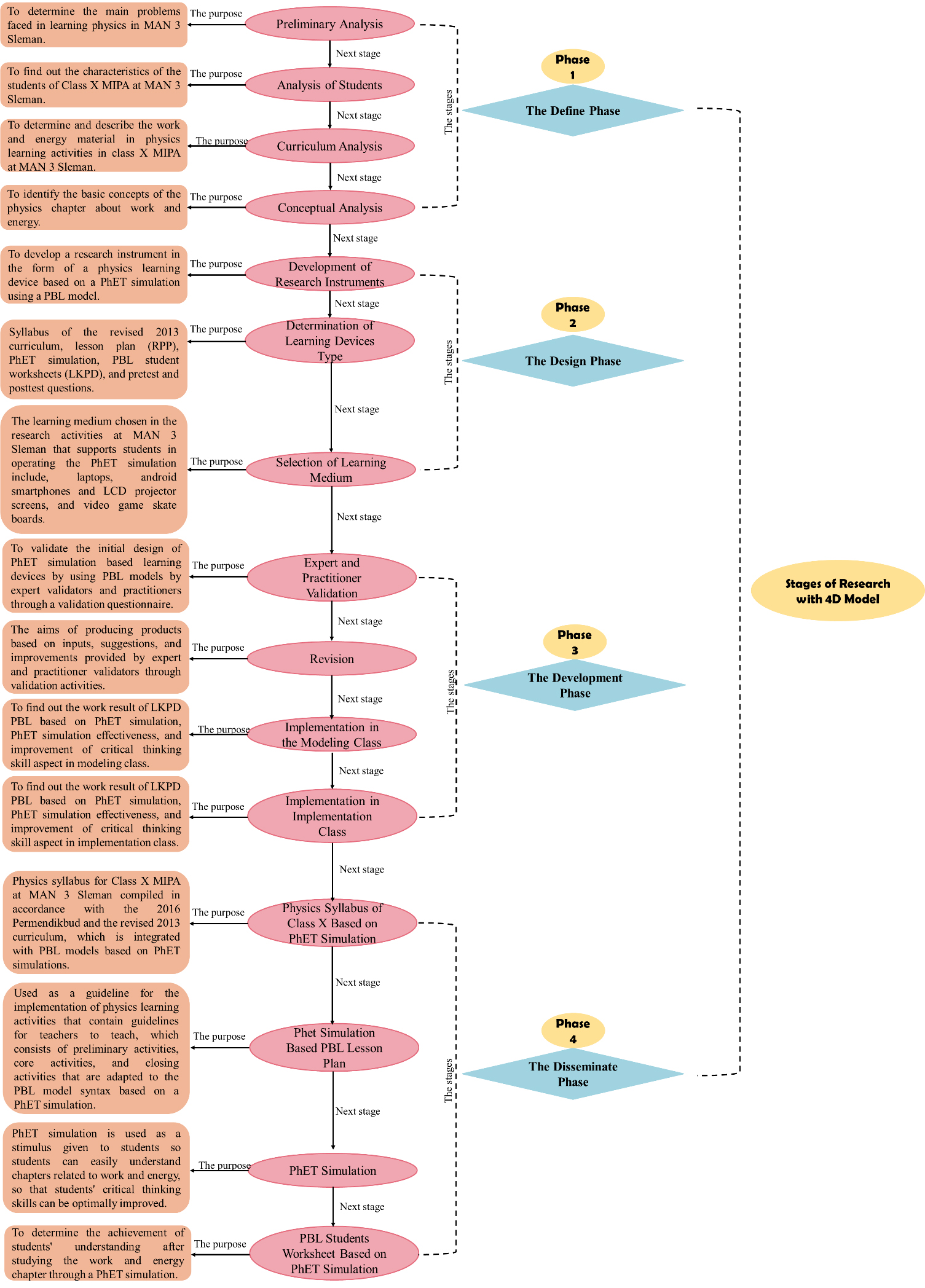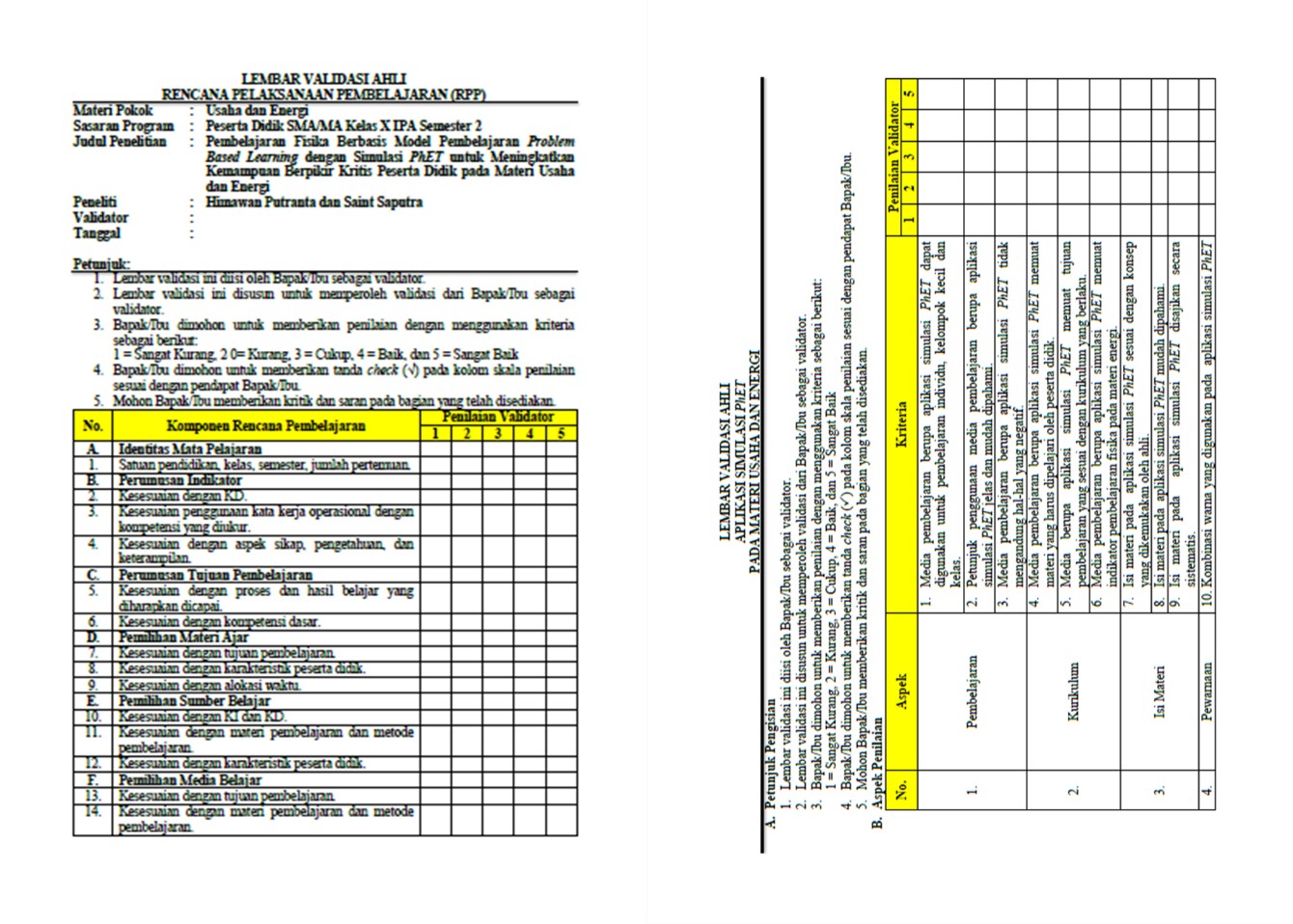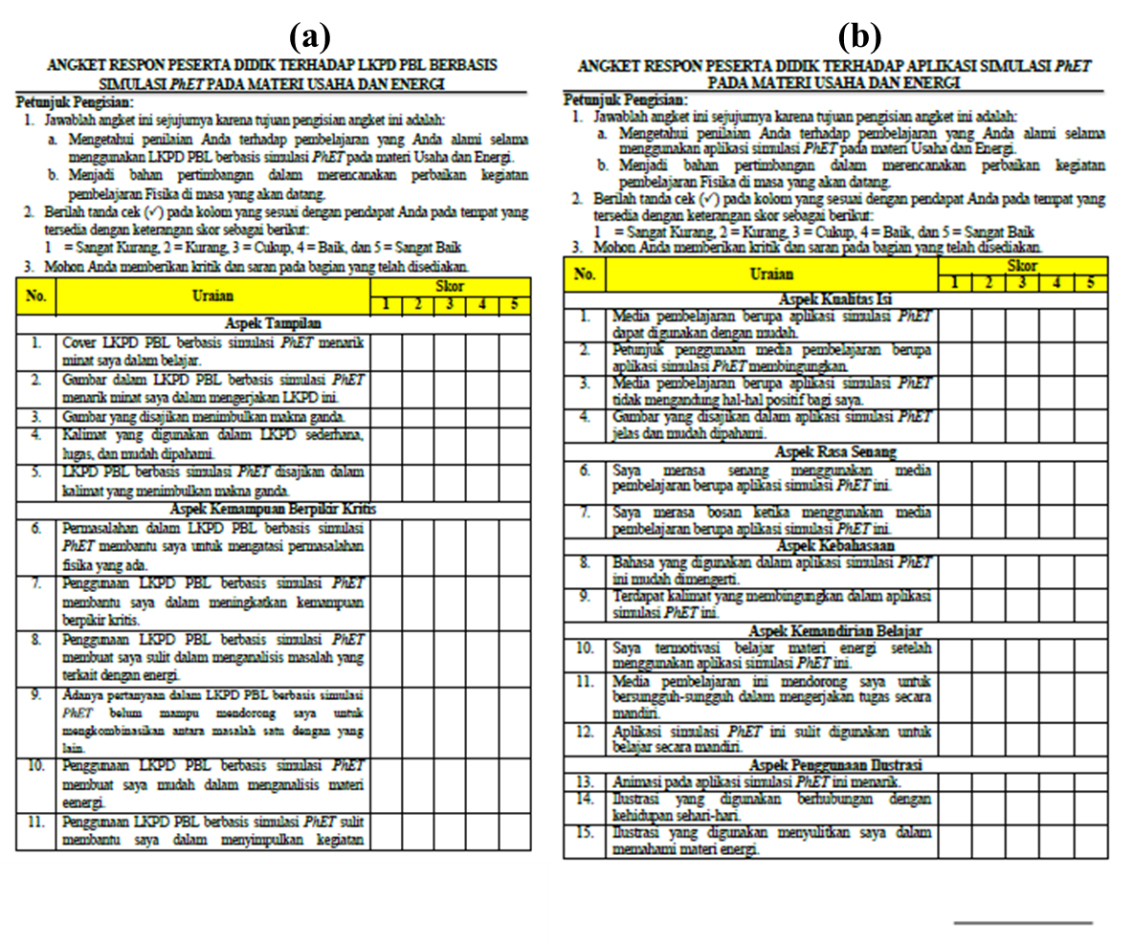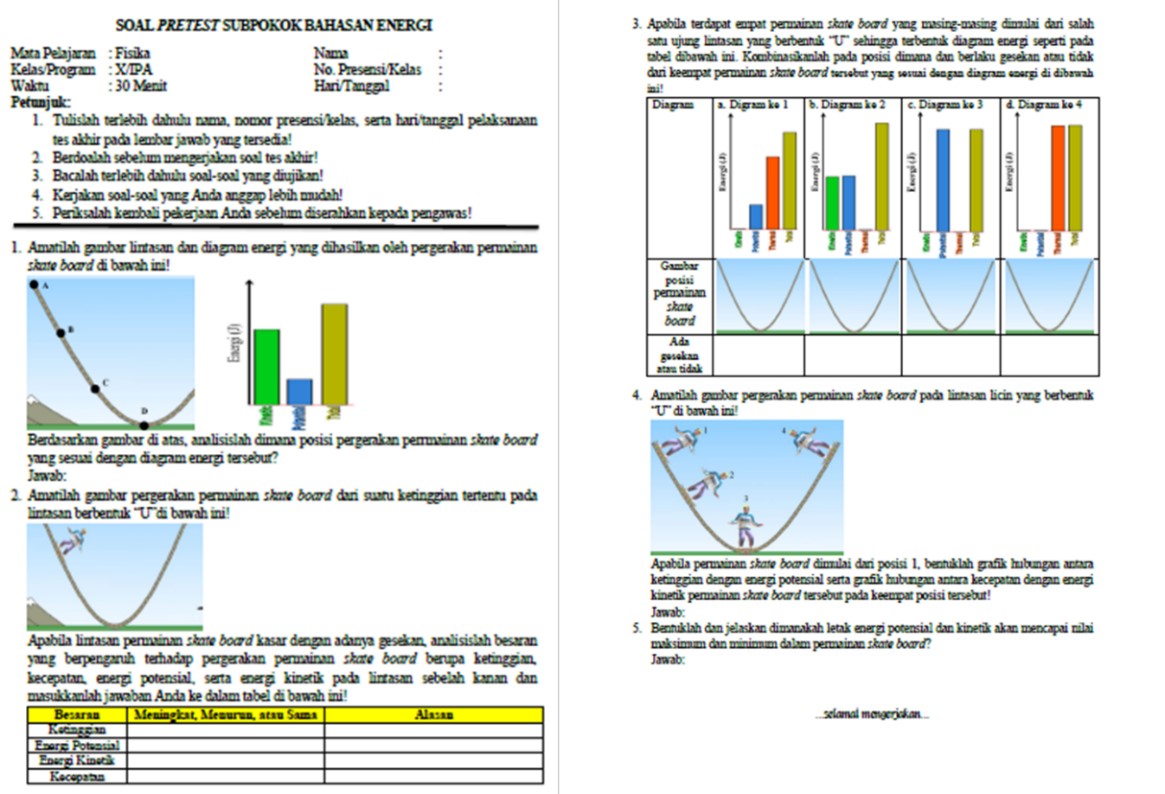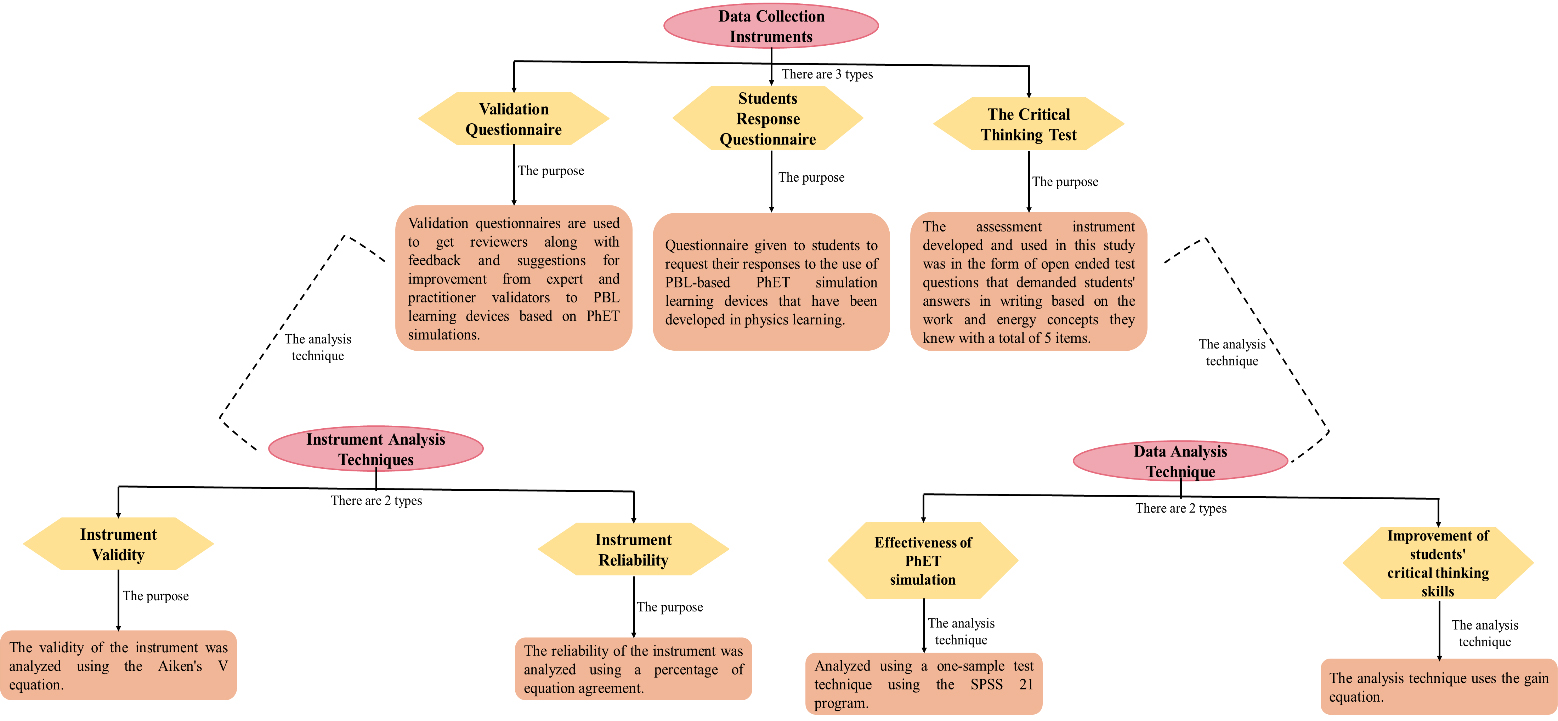Asia-Pacific Forum on Science Learning and Teaching, Volume 20, Issue 1, Article 3 (Aug., 2019) |
This research was conducted in MAN 3 Sleman. MAN 3 Sleman is a high school based on Islam in the Special Region of Yogyakarta, Indonesia. MAN itself stands for Madrasah Aliyah Negeri which is an Islamic religion-based high school in Indonesia. Madrasah Aliyah Negeri is an Islamic-based high school that is under the authority of the Indonesian Ministry of Religion. In addition, students and teachers who are in the MAN environment, especially MAN 3 Sleman are all Muslim and dressed in the Islamic order. In its learning, MAN 3 Sleman students obtain subject matter as is the case with middle school students in general, but are given additional kinds of Islamic religious subject matter. This research was conducted at MAN 3 Sleman in the even semester of academic year 2018/2019 from February-May 2018. In addition, the subjects of the study were the students of class X MIPA at MAN 3 Sleman. MIPA itself is an abbreviation of mathematics and natural science, where the abbreviation is often used in Indonesia. The 10th grade students of MIPA at MAN 3 Sleman are students who are at the second level in Islamic-based high schools with their departments are mathematics and natural sciences. In this study, the class used amounted to two class. The number of students in each class is different, in class X MIPA 1 there are 32 students and class X MIPA 3 has 30 students. Class X MIPA 1 is a modeling class and class X MIPA 3 as an implementation class.
Meanwhile, this research method used in this research is Research and Development (R & D) research method. Sugiyono (2015: 407) states, research methods R & D is a research method used to produce a specific product and test the feasibility of the product. Because of this research using research development or R & D method, the research design used in this research is adapted from 4D model by Thiagarajan et al. (1974). Design research with 4D model consists of 4 main stages: Define (definition); Design (design); Develop (development); and Disseminate (spread).
The define phase aims to define various kinds of problems that occur in physics learning, especially in MAN 3 Sleman and define, also design ways to solve various problems in physics learning activities. In this define phase consists of four main steps carried out in this study as follows. (i) The preliminary analysis; the purpose of the preliminary analysis is to determine the main problems faced in learning physics in high schools, especially in MAN 3 Sleman. Preliminary analysis activities were carried out by observing physics learning activities of class X MIPA in MAN 3 Sleman, interviewing physics teachers in class X MIPA at MAN 3 Sleman, and observing the situations and conditions when physics learning was taking place at MAN 3 Sleman. (ii) The analysis of students; the analysis of students was conducted with the aim to determine the characteristics of class X students at MAN 3 Sleman such as age, academic skills, motivation to learn, levels of cognitive development, and students' critical thinking skills. Meanwhile, the technique of determining the sample as the subject of this study uses a purposive sampling method. Marshall and Rossman (2014) state that the purposive sampling method is a technique or method of taking research subjects that are not based on level and random, but are based on the existence of certain objectives. Students in two classes of X MIPA in MAN 3 Sleman were selected as research samples based on the learning outcomes obtained and the frequency of using smartphones in learning physics. Thus, the characteristics of class X MIPA students at MAN 3 Sleman can be known through observing the behavior displayed by them when they are in class or outside the classroom and also through interviews with physics teachers of class X MIPA at MAN 3 Sleman.
(iii) Curriculum analysis; the purpose of the curriculum analysis phase is to determine and describe physics chapters, especially work and energy chapter in class X physics learning activities that refer to the core competencies and basic Competencies in accordance with the revised 2013 curriculum in MAN 3 Sleman. The curriculum analysis phase is carried out by determining indicators of achievement of competencies and learning objectives in accordance with the basic competencies selected based on the PhET simulation using the problem based learning (PBL) model class X MIPA at MAN 3 Sleman for the work and energy chapter. The selection of work and energy chapter is based on the results of observations and interviews with students and physics teachers of class X MIPA in MAN 3 Sleman which shows that the physics learning outcomes of class X MIPA students from year to year on work and energy materials are lower than the learning outcomes of physics chapters other. In addition, students also find it difficult to understand work and energy material, because energy chapter is abstract so misconceptions often occur on students. The level of misconception of students of class X MIPA in MAN 3 Sleman on work and energy chapter occupies the highest level than the misconception of other physics chapters. (iv) Conceptual Analysis; conceptual analysis is carried out by identifying the basic concepts of the physics chapter on work and energy, with the aim of conveying the material to students systematically, organizing and detailing the concepts of the work and energy chapter, and connecting one concept with another concept to form a concept map related to the work and energy chapter. Meanwhile, the basis for choosing work and energy materials over other physics chapters has been discussed in the curriculum analysis section and in the previous section.
The design phase aims to develop solutions to problem solving in class X MIPA physics learning activities at MAN 3 Sleman identified through observation and interview activities with students and physics class X MIPA students at MAN 3 Sleman. The development of problem solving solutions in physics learning activities is in the form of the development of research instruments and the initial design of learning devices based on PhET simulations using PBL models. This design phase consists of three main steps as follows. (i) Development of research instruments; the development of this research instrument was carried out to develop a research instrument in the form of a physics learning device based on a PhET simulation using a PBL model that aims to solve problems in physics learning activities in class X MIPA in MAN 3 Sleman. (ii) Determination of learning devices type; the learning devices used in research activities at MAN 3 Sleman include the syllabus of the revised 2013 curriculum, which consists of two meetings each for 2 lesson hours and lesson plan (RPP). In addition, the learning device used is the PhET simulation developed by the physics department, University of Colorado. The PhET simulation, developed by the physics department, University of Colorado, is used as a learning medium and also as a medium for solving physics problems about work and energy on student worksheets (LKPD).
The developed LKPD applies several syntaxes from the PBL model. In addition, this study also developed pretest and posttest questions aimed at measuring students' critical thinking skills. These pretest and posttest questions were developed based on cognitive aspects of C4 (analyzing) and C6 (creating) in the revised Bloom taxonomy. These pretest and posttest questions each amount to 5 items open ended questions or description questions that require answers from students to a physics problem in accordance with the work and energy chapter. (iii) Selection of learning medium; the selection of learning medium used in this research activity is done by adjusting the learning devices used during the implementation of research activities. The selection of instructional medium in this study is based on the results of observations and interviews with students and physics teachers at MAN 3 Sleman, where learning medium that are often used by teachers in explaning physics learning materials are using printed books and presentation of physics chapters using Ms. power point. The use of android simulation medium in the form of PhET has never been used by physics teachers at MAN 3 Sleman in supporting the explanation of physics learning materials to their students. In addition, the reason for choosing PhET simulation medium over other medium is because this medium has supported the achievement of the 4.0 industrial revolution in the field of education and this PhET simulation medium is also a simple offline medium in its use. Furthermore, the learning medium chosen in the research activities at MAN 3 Sleman that supports students in operating the PhET simulation include, laptops, android smartphones and LCD projector screens, and video game skate boards.
The development phase is carried out with the aim of producing PBL learning devices based on PhET simulations to improve the critical thinking skills of class X students in MAN 3 Sleman which are valid and reliable. This learning device was developed based on the results of validation and revision results in accordance with comments, suggestions, and expert validators and validation practitioners. In general, the development stage is carried out with the aim of obtaining comments and suggestions for improvement from the validator of experts and practitioners to the design of learning devices that have been developed at the design stage. This development phase consists of four main steps, as follows. (i) Expert and practitioner validation; this stage aims to validate the initial design of PhET simulation based learning devices by using PBL models to improve the critical thinking skills of class X students at MAN 3 Sleman by expert validators and practitioners through a validation questionnaire. Validator experts and practitioners who validate the learning device each amounted to one person. In general, aspects validated by expert and practitioner validators are aspects of the completeness of learning devices, presentation or appearance, physical material, and linguistic aspects.
The questionnaire used by expert and practitioner validators is in the form of a questionnaire asking them to choose the appropriate answer to the learning devices that have been developed. (ii) Revision; the revision stage is conducted with the aim of producing products based on inputs, suggestions, and improvements provided by expert and practitioner validators through validation activities. Furthermore, it produces a PBL-based simulated learning PBL-based learning device to improve the critical thinking skills of students who are revised and ready for use in the coding class and implementation class. (iii) Implementation in the modeling class, implementation of modeling activities by applying learning device PBL-based PhET simulation to improve the critical thinking skills of students who were revised done in class X MIPA 1 with students amounted to 32 students. This activity was conducted to find out the work result of LKPD PBL based on PhET simulation, PhET simulation effectiveness, and improvement of critical thinking skill aspect in modeling class. (iv) Implementation in implementation class; implementation of implementation activities by applying learning device PBL-based PhET simulation to improve the critical thinking skills of students who were revised done in class X MIPA 3 with students amounted to 30. This activity was conducted to find out the work result of LKPD PBL based on PhET simulation, PhET simulation effectiveness, and improvement of critical thinking skill aspect in implementation class.
This disseminate phase aims to disseminate learning device PBL-based PhET simulation to improve aspects of critical thinking skills of students, such as other classes, other teachers, other schools, or published in scientific journals. Meanwhile, the instruments used in this study consisted of two types, i.e learning instruments and data collection instruments. The learning instrument used in this study was in the form of a syllabus of physics class X in the PhET-based work and energy chapter, PBL lesson plans (RPP) based on PhET simulations, PhET simulations, and PBL student worksheets based on PhET simulations. Details and descriptions of the learning instruments used in this study are as follows. (i) Physics syllabus of class X based on PhET simulation; the syllabus used in this study is a physics syllabus for the class X MIPA in MAN 3 Sleman which was prepared in accordance with the 2016 Minister of Education of the Indonesia Republic and the revised 2013 curriculum, but there are some modifications in learning activities using PBL models based on PhET simulations. The physics syllabus of class X based on PhET simulation developed in this study can be shown in Figure 1 below.
Figure 1. The physics syllabus of class X based on PhET simulation
(ii) PhET simulation based PBL lesson plan; the learning plan used as a guideline for the implementation of physics learning activities in this study contains a guide for teachers to teach, which consists of preliminary activities, core activities, and closing activities that are adjusted to the syntax of PBL models based on PhET simulations. In the preliminary activities, the teacher gives apperception and problems to students about events in daily life related to work and energy. This preliminary phase has integrated the syntax of the earliest PBL model, i.e phase 1, the orientation of the students to the problem. After that, in the core activities of students form a study group consisting of 4-5 students. These study groups are formed randomly based on the draw they have obtained. This study group aims to solve the problems given by the physics teacher in the preliminary activities and also to solve work and energy problems in the worksheet that is distributed by the teacher with the assisted of a PhET simulation. PBL model syntax that plays a role in this core activity in the form of phase 2 organizes students to learn in groups; phase 3, guiding the investigation of these physical problems in groups; phase 4, develops and presents the work or results of investigations/solutions to problems discussed in groups; and phase 5, analyzing and evaluating the problem solving process carried out by students in groups. RPP based on PhET simulation based PBL model is expected to support learning activities with PhET simulation based PBL model, so that the aim of learning activities in the form of increasing students' critical thinking skills can be optimally improved. The PhET simulation based PBL lesson plan developed in this study can be shown in Figure 2 below.
Figure 2. The PhET simulation based PBL lesson plan
(iii) PhET simulation; learning medium used in this research is to apply simulation-based learning medium that already exist in the form of PhET simulation. Learning medium in the form of PhET simulation is used as a stimulus given to students so that students can easily research the related chapter of work and energy, so that the critical thinking skills of students can increase optimally. Learning medium in the form of PhET simulation is a medium that simulates events or missions in everyday life such as skate board games that have a relationship with the chapter work and energy. The PhET simulation developed in this study can be shown in Figure 3 below.
Figure 3. The PhET simulation
(iv) The students worksheet (LKPD) PBL based on PhET simulation; this student worksheet (LKPD) PBL based on a PhET simulation is used to determine the achievement of students' understanding after studying the work and energy chapter through a PhET simulation. The LKPD PBL was compiled based on learning objectives and developed according to the syntax in the PBL model based on the PhET simulation. In addition, this LKPD contains a summary of work and energy material, steps for using the PhET simulation along with pictures and instructions for use, and problems regarding work and energy chapter related to the PhET simulation. Do not forget also every part in LKPD is integrated with the syntax or phases contained in the PBL model, and the problems contained in LKPD are also adjusted to the indicators of students' critical thinking skills. The PBL phases used in the development of LKPD are in the form of organizing students to learn and developing and presenting students' work. The LKPD PBL model developed in this study can be shown in Figure 4 below.
Figure 4. Students worksheet (LKPD) PBL based on PhET simulation
In general, the stages carried out in this study apply the 4D research model. The stage diagram of this research can be observed in the following Figure 5.
Figure 5. Diagram of the stages of research using the 4D model
Meanwhile, the data collection instruments used in this study were a validation questionnaire, a student response questionnaire, and a critical thinking skills test. The details and elaboration of the data collection instruments used in this study are as follows. (i) Validation questionnaire; validation questionnaires are used to get reviewers along with feedback and suggestions for improvement from expert and practitioner validators to PBL learning devices based on PhET simulations. PBL learning devices based on PhET simulations have been developed in the form of RPP PBL based on PhET simulations, PhET simulations, LKPD PBL based on PhET simulations, and critical thinking skills tests. The questionnaire used to validate the RPP PBL based on the PhET simulation contains multiple choice questions about aspects of assessment in the RPP, i.e aspects of lesson plan identity, formulation of indicators, formulation of learning objectives, selection of physics chapter, selection of medium and learning resources, learning models, scenarios learning, and assessment. The questionnaire used to validate the PhET simulation contains questions about aspects of ease of operation, appearance, material suitability, and language. The questionnaire used to validate the LKPD PBL based on the PhET simulation contained questions about the didactic aspects, the quality of the material in the LKPD, and the suitability of the LKPD PBL with the PhET simulation. Meanwhile, the questionnaire used to validate the critical thinking skills test contained questions about aspects of the learning guide, the quality of physics chapter in the test, pictures and language, and aspects of conformity with the indicators of critical thinking skills. The validation questionnaire used in this study can be shown in Figure 6.
Figure 6. The validation questionnaire
(ii) Students response questionnaire; student response questionnaire is a questionnaire given to students to request their responses to the use of PBL-based PhET simulation learning devices that have been developed in physics learning. The student response questionnaire used in this study consisted of two student response questionnaires, i.e the student response questionnaire to the PhET simulation and LKPD PBL based on the PhET simulation. The student response questionnaire to the PhET simulation contained questions about aspects of the quality of the material, pleasure, linguistics, learning independence, and aspects of using illustrations. Furthermore, the student response questionnaire to LKPD PBL based on this PhET simulation contained questions about aspects of appearance, language, and aspects of critical thinking skills. The results of the student questionnaire responses are part of the validation of PBL learning devices based on the developed PhET simulations. Meanwhile, the questionnaire responses of students to the simulation of PhET and LKPD PBL based on the simulation of PhET can be shown in Figure 7.
Figure 7. The questionnaire responses of students, i.e (a) to the LKPD PBL based on the simulation of PhET, (b) to the simulation of PhET
(iii) The critical thinking test; the assessment instrument developed and used in this study was in the form of open ended test questions that demanded students' answers in writing based on the work and energy concepts they knew with a total of 5 items. This assessment instrument is given to students in the modeling class and the implementation class in the form of pretests whose implementation is before they get work materials and energy assisted by PhET simulations and posttest is given to students after they get work materials and energy assisted by PhET simulations. This assessment instrument was prepared based on indicators of students' critical thinking skills in accordance with Bloom's revised taxonomy in the cognitive domain in the form of analytical skills (C4) and skills to combine (C6) related to the work and energy chapter. The critical thinking skills assessment instrument developed by researchers and used in this study can be shown in Figure 8.
Figure 8. The critical thinking skills assessment instrument
Meanwhile, the instruments that have been developed by these researchers are then analyzed for their validity and reliability. The instruments analyzed for their validity and reliability in this study included the feasibility of using lesson plans based on PhET simulations, PhET simulations, PBL student worksheets based on PhET simulations, and critical thinking skills tests. The feasibility of PBL learning devices based on PhET simulations that have been developed in the form of RPP PBL based on PhET simulations, PhET simulations, LKPD PBL based on PhET simulations, and critical thinking skills test instruments are obtained from validation scores given by expert and practitioner validators and student response results. Therefore, to analyze the feasibility of PBL learning devices based on PhET simulations that have been developed in the form of RPP PBL based on PhET simulations, PhET simulations, LKPD PBL based on PhET simulations, and critical thinking skills tests obtained from validator assessment and student response results are carried out using the Aiken V equation as shown in Equation 1.
In this case, s is the judge to n, l_o is the lowest validity score, c is the highest validity score, and r is the number given by the assessor to n. Meanwhile, Azwar (2015) stated that the criterion of the validity score of a valuation instrument or learning device obtained based on equation 1 is divided into 5 as shown in Table 1 below.
Table 1. Criteria score of Aiken’s V validity
Validity Score
Category
0.8≤V≤1.0
Very Good
0.6≤V≤0.8
Good
0.4≤V≤0.6
Quite Good
0.2≤V≤0.4
Bad
V≤0.2
Very Bad
After the validation and response students to of learning device PBL based on PhET simulation that has been developed in the form of RPP PBL based on PhET simulation, PhET simulation, LKPD PBL based on PhET simulation, and critical thinking thinking test are analyzed using Aiken's V equation, the next step is to analyze reliability scores of earning device PBL based on PhET simulation that have been done by students in the form of LKPD PBL based on PhET simulation and test of critical thinking skills. The result of reliability analysis from LKPD PBL based on PhET simulation and critical thinking skills test is obtained using percentage of agreement (PA) equation analysis. The way to determine the reliability of LKPD PBL based on PhET simulation and critical thinking skills test is by correcting and evaluating the results of students' work on LKPD PBL based on PhET simulation and critical thinking skills test by two assessors and then tested approval level using the percentage of equation agreement (PA) as shown in Equation 2 (Borich, 1994).
In this case, the PA is the value of the percentage of agreement, A represents a higher total score of the assessor, and B represents a lower total score of the assessor. Based on the value of PA can be known level of approval LKPD PBL based on PhET simulation and the critical thinking test, provided that the percentage agreement value of ≥ 75% and it can be stated that both assessors agree or reliable.
Meanwhile, for data analysis in this study begins by analyzing the effectiveness of instructional media used in the modeling class and implementation class. The effectiveness of instructional medium used in physics learning activities in the modeling class and implementation class in the form of PhET simulation is done by reviewing the effectiveness of PhET simulation from improving the critical thinking skills of students according to Minimum Exhaustiveness Criteria (KKM) in modeling class and class implementation. This PhET simulation effectiveness analysis uses a one-sample t-test technique using the SPSS 21 program. The decision criteria used is Ho rejected if the value of sig. obtained through the SPSS program less than the significance level (α) of 0.05. The reference used in this PhET simulation effectiveness test is 75, which is a Minimum Exhaustiveness Criterion (KKM) score that must be reached by the students after following the physics learning activity using PhET simulation. This value becomes a reference to determine the effectiveness of PhET simulation applied in the learning activity in terms of improvement of students' critical thinking skills to KKM in modeling class and implementation class. Improvement students' critical thinking skills in modeling class and implementation class can be seen through the work of pretest and posttest questions of PhET simulation-based critical thinking skills analyzed using standard gain equations. This technique is done by calculating the value of the gain (Hake, 2012). The standard gain equation used is as shown in Equation 3 below.
In this case g is the standard gain, the post test score is the posttest score obtained by each students, the pretest score is the pretest score obtained by each students, and the maximum score is the likelihood of the students to obtain the greatest score. Based on the information, the maximum score in pretest and posttest in this research is 43. Meanwhile, the interpretation of standard gain values is found in several criteria as in Table 2 below (Hake, 2012).
Table 2. Criteria of Standard Gain Value
Standard Gain Score (g)
Criteria
g>0.7
High
0.3
Medium
g<0.3
Low
After we develop a research instrument for data collection, the next step is to analyze the instrument and analyze the data. The steps that must be considered in the analysis of instruments and data analysis in this study can be observed in the following Figure 9.
Figure 8. Diagram of steps in instrument analysis and data analysis



